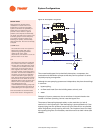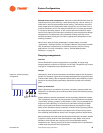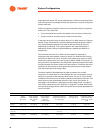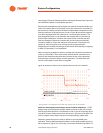
54 Chiller System Design and Control SYS-APM001-EN
System Configurations
When more than one chiller plant is operating, finding the right location
for the differential pressure sensor can be difficult. The point of lowest
pressure in the system shifts depending on which loads are using the most
water. It will probably be necessary to have a number of differential pressure
sensors in the distribution loop. In that instance, the control system
determines the lowest differential pressure signal and uses it to determine
what speed signals to send to the distribution pumps. Sending the same
speed signal to both distribution pumps is simple and will prevent the pumps
from “fighting” each other for the load. However, it will likely result in more
chillers operating than would be required to meet the load (more on this
below). There is one exception: If only one chilled-water plant has an
operating chiller, the distribution pump associated with that plant should be
the only one operating.
Chiller sequencing in a double-ended decoupled system
In addition to pump control, the sequencing of chillers must be integrated
between the two plants. With a double-ended plant, it is possible to have one
plant operating in deficit flow and the other with sufficient surplus flow to
meet the needs of the loads (load/flow imbalance). In other words, a
sufficient number of chillers are operating to meet the load, but the
distribution pumps are not delivering the flow to where it is needed. There
are two solutions to this problem:
1 Adjust the speeds of the distribution pumps to move the water to where it
is needed. This solution is simple in concept but difficult in application
and will not be covered here. It increases complexity and should be
considered carefully prior to implementation. If this is attempted, both
distribution pump speeds should be changed slowly, and in opposite
directions (increase one, decrease the other).
2 Allow each of the plants to make start/stop decisions based on the flow in
its decoupler. In this case, the needs of the loads will be met; however,
more chillers may be running than would otherwise be required.
Starting chillers. When deficit flow is detected at a chilled-water plant, a
chiller associated with that plant should be started. This should start chillers
in the plant closest to the loads using the most water and help avoid the load/
flow imbalance described above. Deficit flow can be detected by either of the
common flow detection methods. (See “Flow-based control” on page 51.)
Note that this limits the operator's flexibility to preferentially start chillers in
the plant further from the load (preferential start may be desirable to load the
plant with the most efficient chillers first, for example).
Stopping chillers. On a single-plant decoupled system, surplus flow through
the decoupler pipe is the normal operating mode. When the surplus flow
exceeds the flow of one of the chillers in the plant by a fixed percentage, that
chiller and its pump can be stopped and the plant will still be creating surplus
flow. On double-ended plants this same logic can be used; however, a chiller
should only be shut off when both plants have sufficient surplus to shut off a
chiller. Only one chiller should be stopped at this time, and it should be the
one in the plant with the most surplus flow. Thus, the normal operating mode
for a double-ended plant is with one plant in surplus and the other operating


















